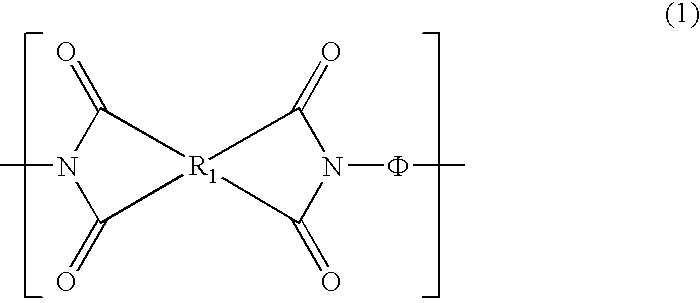Colorless Transparent Polyimide Composite Film and Method for Producing Same
a composite film, transparent technology, applied in the direction of transportation and packaging, synthetic resin layered products, chemistry apparatus and processes, etc., can solve the problems of insufficient film transparency, aggregation of layered silicate, high temperature and a long time period for imidization to proceed, etc., to achieve excellent heat resistance and mechanical properties.
- Summary
- Abstract
- Description
- Claims
- Application Information
AI Technical Summary
Benefits of technology
Problems solved by technology
Method used
Image
Examples
examples
[0067] The present invention will next be described in detail by way of Examples, which should not be construed as limiting the invention thereto.
[0068] Physical properties of polyimides, two-component liquid mixtures (each containing an organic-treated layered silicate and an organic solvent), and polyimide composite films obtained in Examples and Comparative Examples were measured through the below-described methods.
.
[0069] A polyimide (0.1 g) was dissolved in N-methyl-2-pyrrolidone (20 mL), and logarithmic viscosity number of the polyimide was measured at 30° C. by means of a Canon-Fenske viscometer. Logarithmic viscosity number (μ) was calculated by use of the following formula.
[0070]μ=[ln(ts / t0)] / C
[0072] ts: dilute polymer solution flow time
[0073] C: 0.5 g / dL
[0074] Haze of a two-component liquid mixture containing an organic-treated layered silicate and an organic solvent was obtained as an index for evaluating colorlessness and transparency ...
referential example
Synthesis of 1,2,4,5-cyclohexanetetracarboxylic dianhydride
[0080] Pyromellitic acid (552 g), an Rh-on-activated carbon catalyst (product of N.E. Chemcat Corporation) (200 g), and water (1,656 g) were charged into a Hastelloy (HC22) autoclave (inner volume: 5 L), and the atmosphere in the reaction vessel was replaced by hydrogen gas under stirring so that the hydrogen pressure of the reaction vessel was 5.0 MPa, followed by heating to 60° C. While the hydrogen pressure was maintained at 5.0 MPa, reaction was allowed to proceed for two hours. The hydrogen gas contained in the reaction vessel was replaced by nitrogen gas, and the resultant reaction mixture was removed from the autoclave. The reaction mixture was filtered for separation of the catalyst. The filtrate was concentrated through removal of water under reduced pressure by means of a rotary evaporator, to thereby precipitate crystals. The thus-precipitated crystals were subjected to solid-liquid separation at room temperature...
production example 1
Synthesis of Polyimide (A1)
[0081] Oxydianiline (20.12 g, 0.1 mol), and organic solvents; i.e., γ-butyrolactone (51.65 g) having an SP value of 12.6 and N,N-dimethylacetamide (12.92 g) having an SP value of 10.8, were charged into a 500-mL five-necked flask equipped with a thermometer, a stirrer, a nitrogen-introducing tube, and a condenser having a fractionator, followed by dissolution of oxydianiline in the organic solvents. The resultant solution was cooled to 5° C. by means of an ice-water bath. While the solution was maintained at the same temperature, 1,2,4,5-cyclohexanetetracarboxylic dianhydride (22.62 g, 0.1 mol) and triethylamine (0.50 g, 0.005 mol) serving as an imidization catalyst were added together to the solution. After completion of addition, the resultant mixture was heated to 180° C., and subjected to reflux for three hours while a distillate was removed as needed, followed by heating to 200° C. for completion of reaction. After air cooling was performed until the...
PUM
| Property | Measurement | Unit |
|---|---|---|
| Fraction | aaaaa | aaaaa |
| Fraction | aaaaa | aaaaa |
| Thickness | aaaaa | aaaaa |
Abstract
Description
Claims
Application Information
 Login to View More
Login to View More - R&D
- Intellectual Property
- Life Sciences
- Materials
- Tech Scout
- Unparalleled Data Quality
- Higher Quality Content
- 60% Fewer Hallucinations
Browse by: Latest US Patents, China's latest patents, Technical Efficacy Thesaurus, Application Domain, Technology Topic, Popular Technical Reports.
© 2025 PatSnap. All rights reserved.Legal|Privacy policy|Modern Slavery Act Transparency Statement|Sitemap|About US| Contact US: help@patsnap.com



